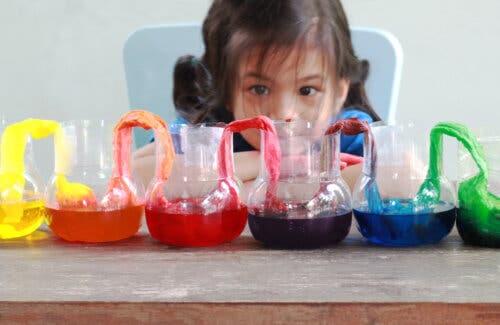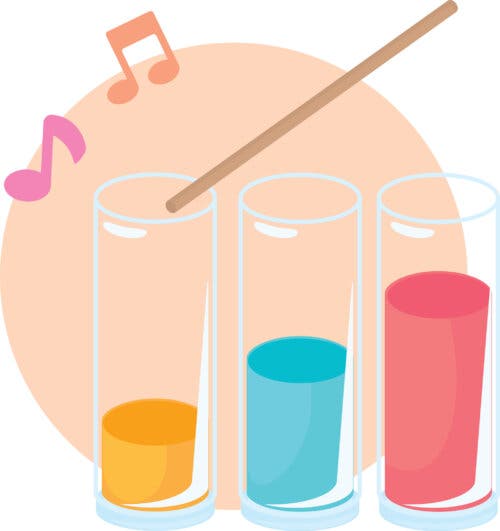4 Water Activities You Can Play Indoors

When we talk about water activities, we tend to imagine activities that take place outside, such as the games we play in the pool, at the beach, or in the yard. But there are so many more options, including activities we can enjoy right inside our homes.
Having a hard time coming up with ideas? We’ll give you several suggestions in today’s article.
4 water activities you can play indoors
Make bubbles in the water
The first of our water activities is a great sort of science experiment for preschool-aged children. To carry out this activity, you need a large bowl or dishpan to fill water as well as a straw and a sponge. Once you have all of the objects, this is what you’ll need to do:
- Fill the bowl or dishpan with water.
- Blow air into the water using your straw, observing how this action produces small bubbles that float to the surface and pop.
- Place a dry sponge in the bottom of the bowl or pan and squeeze, observing how it releases tiny bubbles of air. Then, let go of the sponge so that it floats up and releases larger bubbles.

Make a homemade rainbow
This is another one of our favorite water activities you can play at home. To set it up, you need a large bowl or dishpan, a mirror, and a piece of white poster board. Then, follow the steps below:
- Fill your bowl or dishpan with water and place it in front of a window that the sun is shining on.
- Place your mirror inside, situating it in such a way that the part that’s in contact with the water catches the sun rays coming through the window.
- Place the white posterboard in front of the mirror and move it slowly until you see the colors of the rainbow.
- Observe the homemade rainbow you’re created.
But now you have to ask yourself how does this work? Being able to make a rainbow by following these simple steps has to do with the fact that sunlight is composed of 7 colors. And by following the steps above, you separate these 7 colors and create a rainbow.
Water Xylophone
To create a water xylophone, you’ll need to fill up six glass cups, water, food coloring, and a wooden stick. Then, follow the steps that appear below:
- Set the glasses in a row, one next to the other, adding a different amount of water to each glass.
- Then, add food coloring to each glass in such a way that each glass has different colored water.
- Using the wooden stick, carefully tap each glass, producing different sounds.
- Create melodies by combining the different sounds that your glasses produce.

Bubbles within bubbles
This is the last suggestion on our list of water activities you can try inside your home. What you’ll need is dishwashing detergent, liquid glycerine, a straw, a glass or plastic container, a dish towel, and a flat surface (such as a table). Then, follow the steps below:
- In your container, mix 20 ounces of water, 7 ounces of dishwashing detergent, and 3 ounces of liquid glycerine.
- Moisten your towel with the mixture you prepared and then wipe the towel over a table or other flat surface.
- Blow on the surface with a straw, observing how a soap bubble forms.
- Then, very carefully, introduce a straw into the bubble and blow once again. If you’re careful, then you’ll create another bubble within the one you just made. You can repeat this process several times, creating larger and smaller bubbles within one another. But remember to be very careful, because they can burst at any time.
Enjoy these at-home water activities
We’re sure these water activities have inspired you to try something new while spending time indoors with your family. No matter what’s keeping you from going out, there’s no reason you can’t have some fun and be creative with water.
When we talk about water activities, we tend to imagine activities that take place outside, such as the games we play in the pool, at the beach, or in the yard. But there are so many more options, including activities we can enjoy right inside our homes.
Having a hard time coming up with ideas? We’ll give you several suggestions in today’s article.
4 water activities you can play indoors
Make bubbles in the water
The first of our water activities is a great sort of science experiment for preschool-aged children. To carry out this activity, you need a large bowl or dishpan to fill water as well as a straw and a sponge. Once you have all of the objects, this is what you’ll need to do:
- Fill the bowl or dishpan with water.
- Blow air into the water using your straw, observing how this action produces small bubbles that float to the surface and pop.
- Place a dry sponge in the bottom of the bowl or pan and squeeze, observing how it releases tiny bubbles of air. Then, let go of the sponge so that it floats up and releases larger bubbles.

Make a homemade rainbow
This is another one of our favorite water activities you can play at home. To set it up, you need a large bowl or dishpan, a mirror, and a piece of white poster board. Then, follow the steps below:
- Fill your bowl or dishpan with water and place it in front of a window that the sun is shining on.
- Place your mirror inside, situating it in such a way that the part that’s in contact with the water catches the sun rays coming through the window.
- Place the white posterboard in front of the mirror and move it slowly until you see the colors of the rainbow.
- Observe the homemade rainbow you’re created.
But now you have to ask yourself how does this work? Being able to make a rainbow by following these simple steps has to do with the fact that sunlight is composed of 7 colors. And by following the steps above, you separate these 7 colors and create a rainbow.
Water Xylophone
To create a water xylophone, you’ll need to fill up six glass cups, water, food coloring, and a wooden stick. Then, follow the steps that appear below:
- Set the glasses in a row, one next to the other, adding a different amount of water to each glass.
- Then, add food coloring to each glass in such a way that each glass has different colored water.
- Using the wooden stick, carefully tap each glass, producing different sounds.
- Create melodies by combining the different sounds that your glasses produce.

Bubbles within bubbles
This is the last suggestion on our list of water activities you can try inside your home. What you’ll need is dishwashing detergent, liquid glycerine, a straw, a glass or plastic container, a dish towel, and a flat surface (such as a table). Then, follow the steps below:
- In your container, mix 20 ounces of water, 7 ounces of dishwashing detergent, and 3 ounces of liquid glycerine.
- Moisten your towel with the mixture you prepared and then wipe the towel over a table or other flat surface.
- Blow on the surface with a straw, observing how a soap bubble forms.
- Then, very carefully, introduce a straw into the bubble and blow once again. If you’re careful, then you’ll create another bubble within the one you just made. You can repeat this process several times, creating larger and smaller bubbles within one another. But remember to be very careful, because they can burst at any time.
Enjoy these at-home water activities
We’re sure these water activities have inspired you to try something new while spending time indoors with your family. No matter what’s keeping you from going out, there’s no reason you can’t have some fun and be creative with water.
All cited sources were thoroughly reviewed by our team to ensure their quality, reliability, currency, and validity. The bibliography of this article was considered reliable and of academic or scientific accuracy.
- Curti, A. (2000). Juguemos con la ciencia. Barcelona: Círculo de Lectores, S.A.
This text is provided for informational purposes only and does not replace consultation with a professional. If in doubt, consult your specialist.








